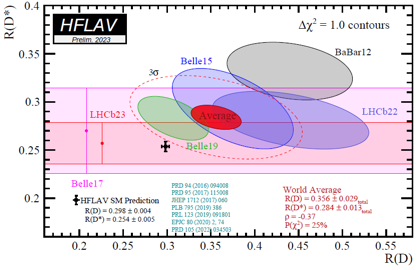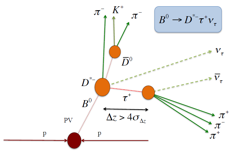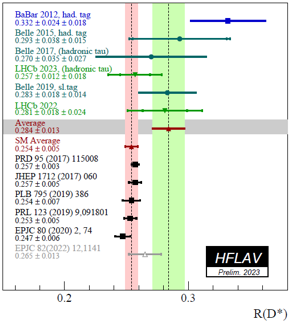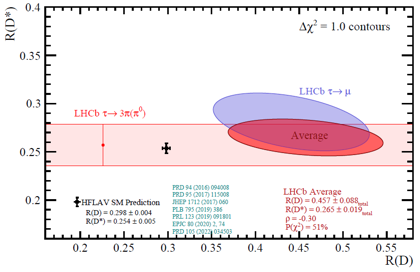Today, at the CERN seminar, the LHCb Collaboration presented a new test of lepton universality, one of the basic principles of the Standard Model (SM) of particle physics. This principle states that the SM treats the three charged leptons (e, μ and τ) identically, except for kinematical effects due to their different masses. In this analysis LHCb physicists compared the B0 mesons decaying into D* charmed mesons together with τ or μ leptons and their corresponding neutrinos. The measured observable is the ratio of branching fractions R(D*) = ß(B→D*τ–ντ) / ß(B→D*μ–νμ). This ratio is particularly interesting since a large class of SM extensions contain new interactions which involve the third generation of quarks and leptons, such as here a b quark (from a B meson) and τ– and ντ leptons. As an example, lepto-quark models could have a sizeable effect, leading to a potentially significant deviation from the SM prediction.
LHCb presented results on R(D) and R(D*) with muonic τ+→μ+νμντ decays in autumn 2022 using the Run 1 data sample. [The R(D) ratio is analogous to the R(D*) except that the D meson replaces the D* meson.] Today’s result reports a measurement of R(D*) using B0→D∗−τ+ντ decays with hadronic τ+→π–π+π+(π0)ντ decays, based on pp collision data collected by the LHCb collaboration at √s = 13 TeV in 2015 and 2016 that updates a Run 1 measurement. The 2015 and 2016 data has a luminosity of 2 fb-1. The new sample has about 1.5 times more B0 decays than the one used previously. The topology of the decay is represented on the image at the top of this news. The analysis strategy was improved with respect to the previous measurement.
The value R(D*-)=0.247±0.015±0.015±0.012 has been reported at the Rencontre de Physique de la Vallée d’Aoste, 8 March 2023, and at the seminar today, where the first uncertainty is statistics, the second systematics, and the third uncertainty is related to the external branching fractions used in the analysis. When combined with the Run 1 result the value R(D*-)=0.257±0.012±0.014±0.012 is obtained. This result is compatible with the present world average and with the SM expectation and is one of the most precise single measurements of R(D*) to date. In the future, it will be further improved by including the remaining Run 2 data collected in 2017 and 2018, corresponding to an extra integrated luminosity of 4 fb-1. The image shows the comparison of LHCb results with those from BaBar and Belle collaborations, as well as the experimental and the SM averages.

This LHCb R(D*) hadronic τ decay result can be further combined with the LHCb leptonic R(D*)/R(D) blue elliptic shape result as seen in the image above to the left leading to the new elliptic red shape “Average”. The numerical values are shown in the image. Finally today’s LHCb result, marked “LHCb23” is included in the world average giving the new combination result as “Average” red ellipse at the image above to the right. The numerical values are also included in the image. The SM prediction is indicated as the black cross. The deviation of experimental results with respect to the SM is 3.2 standard deviations.
Lepton Flavour Universality can be studied in two classes of B meson decays in which a beauty b quark can be transformed into either a strange quark (b→s) or into a charm quark (b→c). In December 22 the LHCb collaboration announced that the results of a new analysis of b→s decays show an agreement with the SM. In the measurement released today it is instead the b→c decays that are studied. This domain of research has previously been dominated by the B factories (BaBar, Belle), as it was originally thought difficult to measure at the LHC. Now, with the R(D*) result of today and the R(D)/R(D*) measurements of autumn ’22, LHCb has a similar precision to the B factories on R(D*) and demonstrates its capabilities as a major player in this field.
Read more in the LHCb seminar presentation, in the winter conferences [1], [2] and [3], and also in the forthcoming paper.



